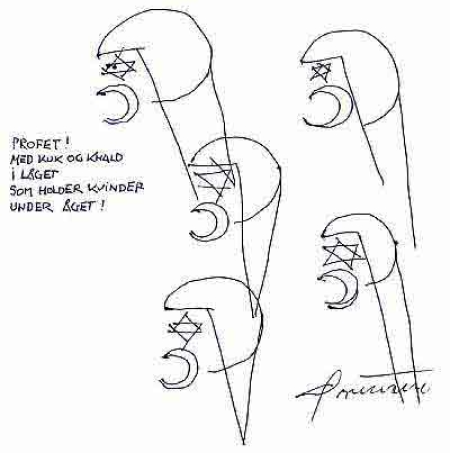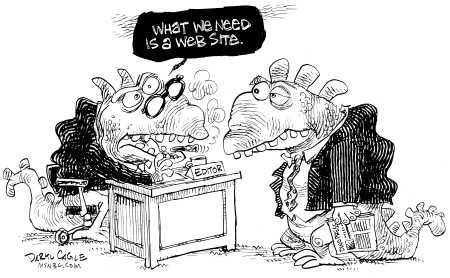We’ve been getting a crazy reaction to a recent column we syndicated by Tom Purcell. Stark raving crazy readers have been flooding us with email and phone calls complaining about the column below, which makes a tongue-in-cheek argument that Girl Scout Cookies should be banned. We’ve learned that you don’t joke about little girls. If you want to comment on the column, click here.
Considering the flood of e-mail from shallow readers, I asked Tom for a comment:
I’d like to say I was surprised by some of the responses I got to a satirical column that calls for a ban on Girl Scout cookies, but the truth is I wasn’t surprised at all.
The idea in the column below was to poke fun at some of the stridency we see on op/ed pages by folks who lecture the rest of us on what we must do to save the world. You might think it obvious that readers would see the gag — what kind of nut would attack Girl Scouts and demand that their cookie sale be banned to save the environment and protect us from a host of other ills — but a number of readers didn’t see the gag.
Some of the early mail I got came from folks on the left who praised me for being anti-capitalist. Much of the mail came from Girl Scout moms who thought I was dead serious. Some of these folks actually called the editors at their local paper to complain; others called Cagle Cartoons directly. They were mighty angry at this writer and responded to my “attack” on the Girl Scouts point by point. Interestingly, the later mail has come from people who saw the real point of the column and got a kick out of it.
In any event, Cagle’s Sales has a theory as to why many folks missed the gag. Though it’s true readers have misunderstood satirical pieces in their local newspaper in the past — think Mike Royko and Art Buchwald — could it be that these days it’s hard to tell the difference between satire and columnists who really mean what they are writing — who really don’t see the silliness in their point of view and the demands that they’re making on the rest of us? –Tom Purcell
Here is the offending column:
Why Girl Scout Cookies Must Be Banned
By Tom Purcell
The Girl Scout cookie season is upon us. That means one thing. The annual cookie sale must be banned.
How can we allow anyone, in these progressive times, to inflict empty calories on an already obese public?
How can we be so inconsiderate to diabetics and others who are unable to consume sugar?
How can we allow any organization, regardless of its cause, to use children to pimp products loaded with trans fat, the partially hydrogenated oil that Americans fear more than communism?
It is true that the Girl Scouts organization was founded in 1912 to help girls develop physically, mentally and spiritually. I know the annual cookie sale has become a tasty part of American culture since it originated in 1917.
But the fact is this: The annual sale is teaching girls TERRIBLE values.
It is teaching them raw capitalism — how to exploit the weak and the helpless. My own niece, an otherwise sweet and lovely child, knows I can’t help but eat shortbread cookies by the row. I eat Thin Mints as though they were Tic Tacs. I down Peanut Butter Patties the way grizzlies dine on wild salmon.
I’m addicted. But rather than protect me from my addiction, she preys on me. She calls or visits just before dinner — when I am at my most hungry and vulnerable. She tells me about her troop’s good deeds and how my order will fund even more.
The clever little manipulator always walks away with a sizable order.
All Girl Scouts do. They probably meet in private to laugh about the helplessness of their victims — they laugh about the strong-arm techniques they use to part friends, family and neighbors from their hard-earned dough.
In the process, they are destroying our environment. More than 200 million boxes of Girl Scout cookies are sold every year — that’s $700 million in annual revenue. Precious trees must be felled to farm the grains and sugars needed to produce them — trees that are essential to dissipating carbon dioxide.
What’s worse, as those cookies are manufactured, packaged and shipped, more carbon dioxide is pumped into the air. That’s right, the Girl Scouts are causing the Arctic ice cap to melt. The next time you dip a shortbread cookie into a cup of milk, the least you can do is remember the starving polar bears stranded on hideously small ice floes.
That’s why the annual Girl Scout cookie sale must end.
Look, if the Girl Scouts want to teach girls how to market products and manage inventory and money, can’t they be more socially responsible? Instead of selling cookies, why not sell low-energy-consumption light bulbs? Why not sell something that makes the girls aware of man’s thoughtless destruction of our fragile ecosystems?
Better yet, instead of teaching the girls the principles of capitalism, why not teach them how to be government bureaucrats instead? America is moving toward European-style socialism. The careers of the future will be in government, not the private sector. Why not have the government produce a pamphlet on the harmful effects of cookies, then mandate that the girls develop a program to distribute it?
Sure, I know some people will criticize me for demanding an end to the cookie sale. They’ll say that it really does teach girls useful business skills. They’ll say that it’s as much a part of American culture as baseball and apple pie — that we should celebrate it and enjoy it. They’ll say that America has real problems and that I ought to focus on those rather than something as harmless as a lousy cookie sale.
Well, nuts to that. I urge you to write your senator and congressperson. If the Girl Scouts won’t willingly stop foisting their cookie pox on the rest of us, we must use the might of the federal government to mandate a ban on their annual sale.
I hope the ban goes into effect before my niece talks me into placing another order.
If you want to comment on Tom’s offensive column, click here
Here is some cartoon supporting evidence for Tom’s position:

Cartoon by M. e. Cohen, Comment on this cartoon.

Cartoon by Mike Lester of the Rome (GA) News-Tribune, Comment on this cartoon.

Cartoon by Joe Heller of the Green Bay Press-Gazette, Comment on this cartoon.
 I knew this would happen – I’m getting complaints about the relative sizes of the fish in my Google/Yahoo/Microsoft cartoon. Here is an example:
I knew this would happen – I’m getting complaints about the relative sizes of the fish in my Google/Yahoo/Microsoft cartoon. Here is an example: 




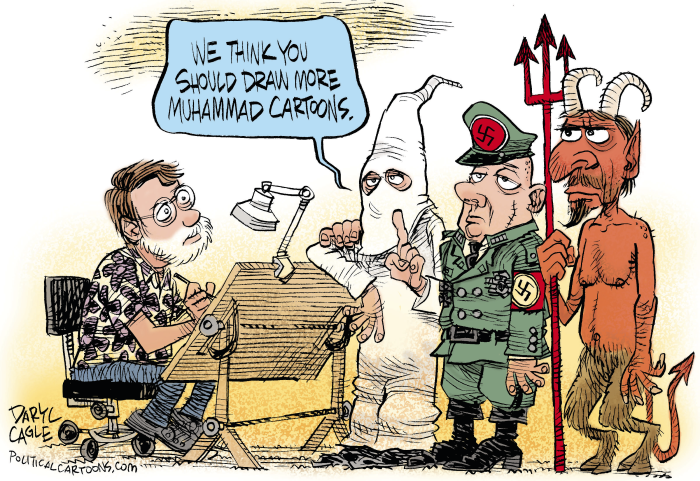






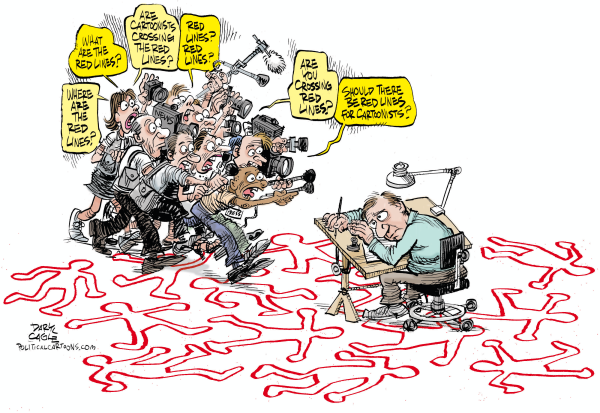


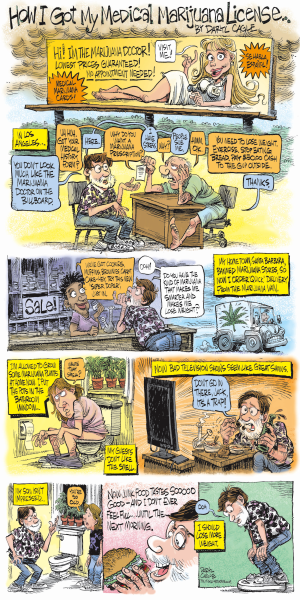




 I’m pleased to add three new foreign cartoonists to our site today. Jens Hage is an award winning ‘toon talent from Denmark, he is a freelancer for the Danish national newspaper “BerlingskeTidende” (the world’s oldest newspaper) and works on the staff for the annual Danish satirical book “Blæksprutten” (the Octopus), which has been published for 116 years.
I’m pleased to add three new foreign cartoonists to our site today. Jens Hage is an award winning ‘toon talent from Denmark, he is a freelancer for the Danish national newspaper “BerlingskeTidende” (the world’s oldest newspaper) and works on the staff for the annual Danish satirical book “Blæksprutten” (the Octopus), which has been published for 116 years.  Jeremy Nell’s cartoons, titled “Ditwits,” appear on the front page of one of the largest daily, national newspapers in South Africa, “
Jeremy Nell’s cartoons, titled “Ditwits,” appear on the front page of one of the largest daily, national newspapers in South Africa, “ Our third new cartoonist is Khalil Rahman who is the staff cartoonist for the Bengali newspaper, the Daily Naya Diganta in Dhaka, Bangladesh.
Our third new cartoonist is Khalil Rahman who is the staff cartoonist for the Bengali newspaper, the Daily Naya Diganta in Dhaka, Bangladesh. 



